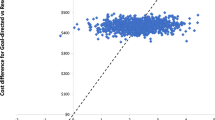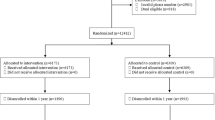Abstract
Objective:
Evaluate effectiveness of weight-loss interventions in a managed care setting.
Methods:
Three-arm randomized clinical trial: usual care, mail, and phone intervention. Participants were 1801 overweight managed care organization (MCO) members. Measures included baseline height, weight at baseline and 24 months, self-reported weight at 18 months. Intervention and participation in other weight-related programs was monitored across 24 months.
Results:
Weight losses were 2.2, 2.4, and 1.9 kg at 18 months in the mail, phone, and usual care groups, respectively. Mail and phone group weight changes were not significantly different from usual care (P<0.35).Weight losses at 24 months did not differ by condition (0.7 kg mail, 1.0 kg phone, and 0.6 kg usual care, P=0.55). Despite treatment availability over 24 months, participation diminished after 6 months. Participation was a significant predictor of outcomes in the mail and phone groups at 18 months and the mail group at 24 months. Cost-effectiveness of phone counseling was $132 per 1 kg of weight loss with mail and usual care achieving similar cost-efficiency of $72 per 1 kg of weight loss.
Conclusion:
Although mail- and phone-based weight-loss programs are a reasonably efficient way to deliver weight-loss services, additional work is needed to enhance their short- and long-term efficacy.
This is a preview of subscription content, access via your institution
Access options
Subscribe to this journal
Receive 12 print issues and online access
$259.00 per year
only $21.58 per issue
Buy this article
- Purchase on Springer Link
- Instant access to full article PDF
Prices may be subject to local taxes which are calculated during checkout


Similar content being viewed by others
References
Flegal KM, Carroll MD, Kuczmarski RJ, Johnson CL . Overweight and obesity in the United States: prevalence and trends, 1960–1994. Int J Obes Relat Metab Disord 1998; 22: 39–47.
Mokdad AH, Bowman BA, Ford ES, Vinicor F, Marks JS, Koplan JP . The continuing epidemics of obesity and diabetes in the United States. JAMA 2001; 286: 1195–1200.
Ogden CL, Flegal KM, Carroll MD, Johnson CL . Prevalence and trends in overweight among US children and adolescents, 1999–2000. JAMA 2002; 288: 1728–1732.
Flegal KM, Carroll MD, Ogden CL, Johnson CL . Prevalence and trends in obesity among US adults, 1999–2000. JAMA 2002; 288: 1723–1727.
Manson JE, Bassuk SS . Obesity in the United States: a fresh look at its high toll. JAMA 2003; 289: 229–230.
Calle EE, Thun MJ, Petrelli JM, Rodriguez C, Heath CW . Body-mass index and mortality in a prospective cohort of US adults. N Engl J Med 1999; 341: 1097–1105.
Paffenbarger R, Hyde R, Wing A, Lee I-M, Jung D, Kampert J . The association of changes in physical-activity level and other lifestyle characteristics with mortality among men. N Engl J Med 1993; 328: 538–545.
Wilson PWF, D'Agostino RB, Sullivan L, Parise H, Kannel WB . Overweight and obesity as determinants of cardiovascular risk: the framingham experience. Arch Intern Med 2002; 162: 1867–1872.
Mokdad AH, Marks JS, Stroup DF, Gerberding JL . Actual causes of death in the United States, 2000. JAMA 2004; 291: 1238–1245.
O'Meara S, Riemsma R, Shirran L, Mather L, ter Riet G . A systematic review of the clinical effectiveness of orlistat used for the management of obesity. Obes Rev 2004; 5: 51–68.
Arterburn DE, Crane PK, Veenstra DL . The efficacy and safety of sibutramine for weight loss: a systematic review. Arch Intern Med 2004; 164: 994–1003.
NHLBI. Clinical Guidelines on the Identification, Evaluation, and Treatment of Overweight and Obesity in Adults. NIH, NHLBI: Bethesda, MD, 1999.
Jeffery RW, Drewnowski A, Epstein LH, Stunkard AJ, Wilson GT, Wing RR et al. Long-term maintenance of weight loss: current status. Health Psychol 2000; 19 (Suppl 1): 5–16.
French SA, Jeffery RW . Consequences of dieting to lose weight: effects on physical and mental health. Health Psychol 1994; 13: 195–212.
French SA, Jeffery RW, Murray D . Is dieting good for you? Prevalence, duration and associated weight and behaviour changes for specific weight loss strategies over four years in US adults. Int J Obes Relat Metab Disord 1999; 23: 320–327.
Jeffery RW, Folsom AR, Luepker RV, Jacobs Jr DR, Gillum RF, Taylor HL et al. Prevalence of overweight and weight loss behavior in a metropolitan adult population: the Minnesota Heart Survey experience. Am J Public Health 1984; 74: 349–352.
Volkmar FR, Stunkard AJ, Woolston J, Bailey RA . High attrition rates in commercial weight reduction programs. Arch Intern Med 1981; 141: 426–428.
Hellerstedt WL, Jeffery RW . The effects of a telephone-based intervention on weight loss. Am J Health Promot 1997; 11: 177–182.
Cameron R, MacDonald MA, Schlegal RP, Young CI, Fisher SE, Killen JD et al. Toward the development of self-help health behaviour change programs: weight loss by correspondence. Can J Public Health 1990; 81: 275–279.
Jeffery RW, Danaher BG, Killen J, Farquhar JW, Kinnier R . Self-administered programs for health behavior change: smoking cessation and weight reduction by mail. Addict Behav 1982; 7: 57–63.
Jeffery RW, Gerber WM . Group and correspondence treatments for weight reduction used in the Mulitple Risk Factor Intervention Trial. Behav Ther 1982; 13: 24–30.
Black DR, Threlfall WE . A stepped approach to weight control: a minimal intervention and a bibliotherapy problem-solving program. Behav Ther 1986; 17: 144–157.
Marston AR, Marston MR, Ross J . A correspondence course behavioral program for weight reduction. Obes/Bariatric Med 1977; 6: 140–147.
Linstrom LL, Balch P, Reese S . In person versus telephone treatment for obesity. J Behav Ther Exp Psychiat 1976; 7: 367–369.
US Preventive Services Task Force. Screening for Obesity in Adults. US Preventive Services Task Force, Agency for Healthcare Research and Quality: Rockville, MD, December 2003.
Jeffery RW, McGuire MT, Brelje KL, Pronk NP, Boyle RG, Hase KA et al. Recruitment to mail and telephone interventions for obesity in a managed care environment: the Weigh-To-Be project. Am J Manag Care 2004; 10: 378–382.
Pronk NP, Boucher JL, Gehling E, Boyle RG, Jeffery RW . A platform for population-based weight management: description of a health plan-based integrated systems approach. Am J Manag Care 2002; 8: 847–857.
Jeffery RW, Sherwood NE, Brelje K, Pronk NP, Boyle R, Boucher JL et al. Mail and phone interventions for weight loss in a managed-care setting: Weigh-To-Be one-year outcomes. Int J Obes Relat Metab Disord 2003; 27: 1584–1592.
Moher D, Schulz KF, Altman DG . The CONSORT statement: revised recommendations for improving the quality of reports of parallel-group randomised trials. Lancet 2001; 357: 1191–1194.
Finkelstein EA, Fiebelkorn IC, Wang G . National medical spending attributable to overweight and obesity: how much, and who's paying? Health Aff (Millwood) 2003; (Suppl): W3-219-226.
The Diabetes Prevention Program (DPP). Description of lifestyle intervention. Diabetes Care 2002; 25: 2165–2171.
Jeffery RW, French SA . Preventing weight gain in adults: design, methods and one year results from the Pound of Prevention study. Int J Obes Relat Metab Disord 1997; 21: 457–464.
Baker RC, Kirschenbaum DS . Self-monitoring may be necessary for successful weight control. Behav Ther 1993; 24: 377–394.
Author information
Authors and Affiliations
Corresponding author
Rights and permissions
About this article
Cite this article
Sherwood, N., Jeffery, R., Pronk, N. et al. Mail and phone interventions for weight loss in a managed-care setting: weigh-to-be 2-year outcomes. Int J Obes 30, 1565–1573 (2006). https://doi.org/10.1038/sj.ijo.0803295
Received:
Revised:
Accepted:
Published:
Issue Date:
DOI: https://doi.org/10.1038/sj.ijo.0803295
Keywords
This article is cited by
-
An Acceptance Based Lifestyle Intervention in Black Breast Cancer Survivors with Obesity
Journal of Immigrant and Minority Health (2022)
-
Using targeting to recruit men and women of color into a behavioral weight loss trial
Trials (2020)
-
The evaluating self-management and educational support in severely obese patients awaiting multidisciplinary bariatric care (EVOLUTION) trial: principal results
BMC Medicine (2017)
-
Fresh Start, a postpartum weight loss intervention for diverse low-income women: design and methods for a randomized clinical trial
BMC Public Health (2016)
-
Feasibility, effectiveness and cost-effectiveness of a telephone-based weight loss program delivered via a hospital outpatient setting
Translational Behavioral Medicine (2016)



